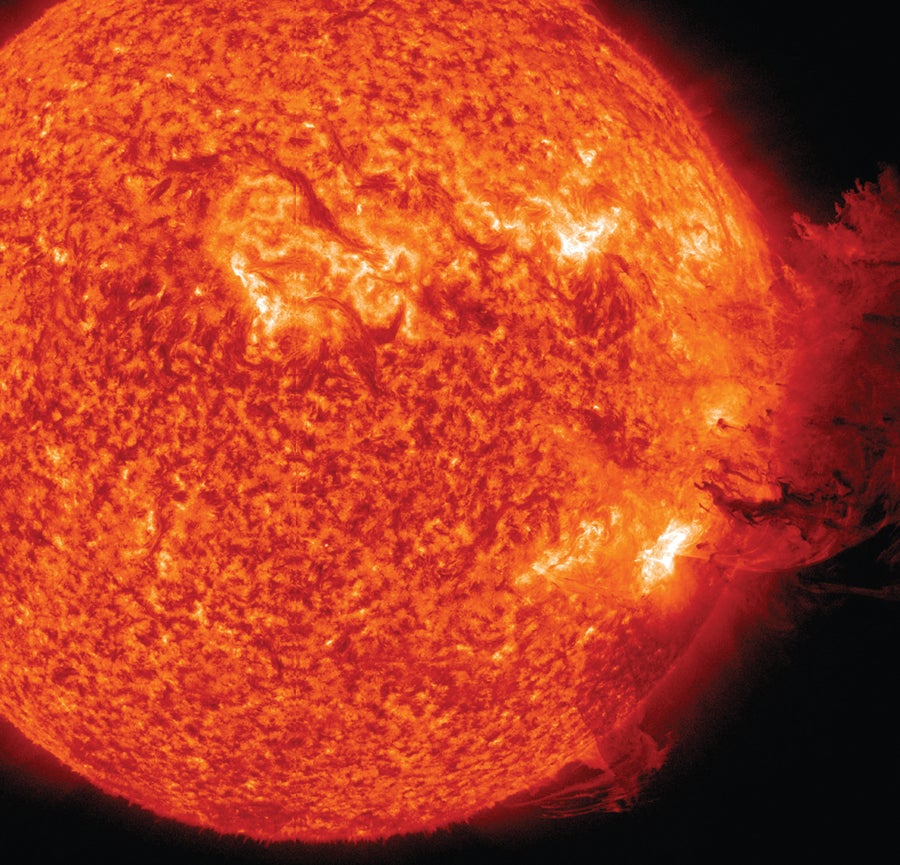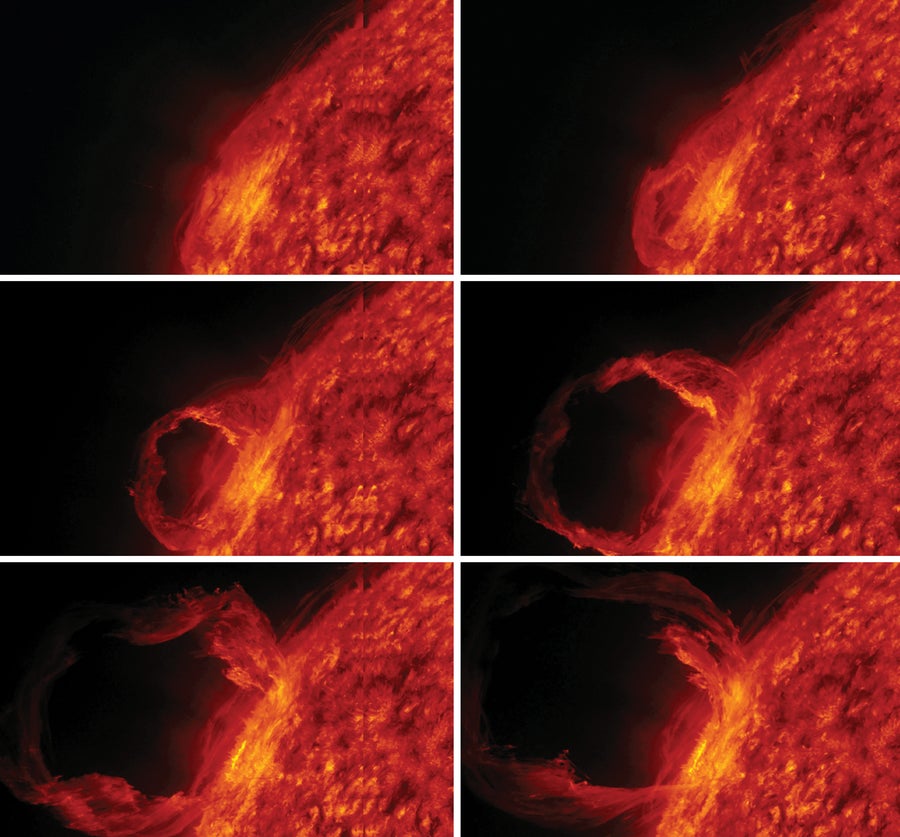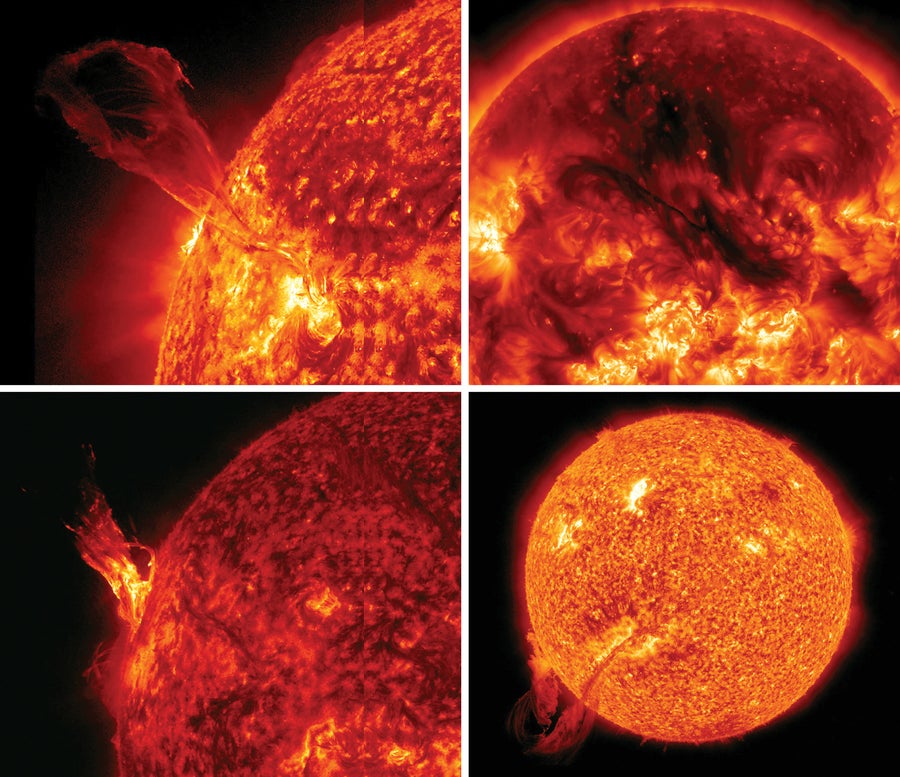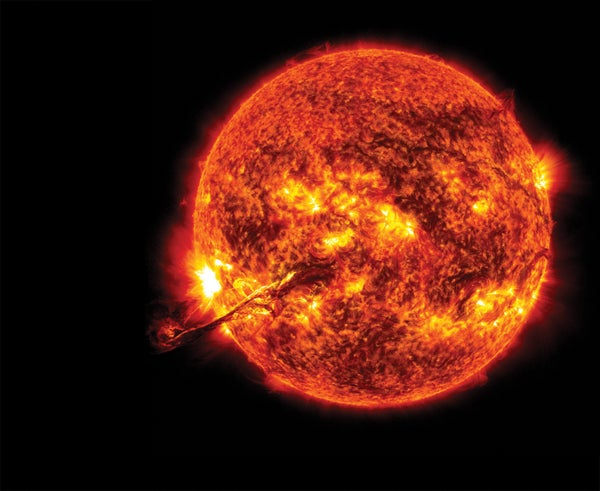Every now and then our star produces immense flares of particles and radiation that can wreak havoc on Earth. For more than 150 years scientists studying these outbursts and how they affect our planet have placed great focus on a single, seemingly pinnacle example: the Carrington Event of 1859. An eruption from the sun walloped Earth, pumping enough energy into our planet’s magnetic field to set off a massive geomagnetic storm that created beautiful auroral displays but also sparked electrical fires in telegraph lines. The storm was seen as an odd, minor inconvenience that caused limited damage to the electrical infrastructure of the time. Researchers today, however, recognize the Carrington Event, along with a 1921 storm of comparable strength, as an ominous warning of future catastrophes.
The first indication that solar storms could be even worse came in 2012, with the discovery of a mega storm some 10 to 100 times stronger than the Carrington Event that occurred around A.D. 775. “It was really, really astounding,” says Nicolas Brehm of ETH Zurich. “We didn’t think something of this magnitude could happen.”
The ancient mega storm might have come from a once-in-10,000-years “superflare,” an event thousands of times more powerful than a regular solar flare, scientists speculated at the time. A direct hit by such a superflare today would have devastating consequences for our globally wired society.
On supporting science journalism
If you're enjoying this article, consider supporting our award-winning journalism by subscribing. By purchasing a subscription you are helping to ensure the future of impactful stories about the discoveries and ideas shaping our world today.
Now these phenomena appear to be even more common than we thought: researchers investigating the geochemical annals of Earth’s recent history have now found evidence for two more.
In a paper led by Brehm, available as a preprint on Research Square, scientists reveal the possible discovery of two frightfully strong solar events. One occurred in 7176 B.C., when nomadic hunter-gatherer societies were giving way to agrarian settlements. The other happened in 5259 B.C., as the planet emerged from the last ice age. Both events are thought to have been at least as strong as the one in A.D. 775, and for the past decade scientists have been searching for similarly extreme occurrences. Brehm’s team is the first to find some. “It’s a great achievement,” says Fusa Miyake of Nagoya University in Japan, who led the study in 2012 that revealed the 775 event. Scientists now refer to such superflares as “Miyake events.”

Solar flares and sheets of glowing plasma rise from a region of intense activity on the sun. Credit: NASA, SDO and the AIA, EVE and HMI science teams
To look for these solar flares, researchers rely on chemical analyses of samples from polar ice caps and from ancient trees preserved in waterlogged bogs or high on mountaintops. When solar particles hit the atmosphere, they can produce unstable radioactive forms of various elements, called isotopes, that accumulate in these places. For example, solar activity can form carbon 14, which is absorbed by trees as they grow. Because each ring within a tree’s trunk corresponds to a single year of growth, scientists can determine the precise dates of any isotope spikes caused by increased solar activity: the more carbon 14 there is in one ring, the more solar particles were hitting our atmosphere at that time. Such rings “allow us to reconstruct patterns of radiocarbon through time,” says Charlotte Pearson of the Laboratory of Tree-Ring Research at the University of Arizona, who is a co-author on Brehm’s paper. “One of the key things that drives those fluctuations is the activity of the sun.”
By studying the concentrations of beryllium 10 and chlorine 36 in ice cores, scientists can make similar though slightly less accurate measurements. Together the two methods can provide a precise account of historical events. We have tree-ring data for most of the Holocene—the current geologic epoch, which began about 12,000 years ago. Poring over them to search for carbon 14 spikes is time-consuming, however. Looking at just a single year typically requires weeks of analyzing and cross-correlating multiple tree-ring samples. “There’s 12,000 years of the Holocene to do, and we’ve done 16 percent of it,” says Alexandra Bayliss, head of scientific dating at Historic England and a co-author on the paper. “It’s a matter of time and money.”
Brehm and his team got lucky. For the event in 7176 B.C., they first saw preliminary evidence for a beryllium 10 spike in ice cores. The researchers followed up with tree rings and saw a corresponding spike of carbon 14. For the event in 5259 B.C., Bayliss had noticed a gap in archaeological data around this time period. Studying carbon 14 data in tree rings from this era, the team found another spike. “We found this huge increase” for both dates, Brehm says, each similar in magnitude to the spikes Miyake found in the samples that clinched the A.D. 775 event.

A planet-dwarfing solar prominence erupts from our star, unleashing massive amounts of matter and radiation. Credit: NASA, SDO and the AIA, EVE and HMI science teams
At first scientists were unsure what had caused these spikes, and some even thought solar events were unlikely. A 2013 study led by Brian Thomas of Washburn University, however, showed solar flares were the probable culprit. “There were people making suggestions [that the 775 spike] could be from a supernova or even a gamma-ray burst,” says Thomas, who was not involved in the latest paper by Brehm and his colleagues. “But they’re just too rare to cause this kind of frequency. It doesn’t fit as well as the solar explanation.” Such large, frequent spikes, he argues, were more likely the result of increased solar activity—possibly accompanied by a geomagnetic storm similar to the Carrington Event but far more powerful. “The Carrington Event isn’t even detectable” in tree rings and ice cores, Bayliss notes, which suggests it was minuscule by comparison.
Even so, the exact correlation between spikes in solar particles and the intensity of any accompanying geomagnetic storm remains unclear. “A big particle event is often associated with a geomagnetic storm, but it doesn’t necessarily have to be,” Thomas says. It may even be that geomagnetic storms like the Carrington Event do not cause spikes in carbon 14 at all—that would explain its absence from tree-ring and ice-core data dated to the event. There are hints, however, that at least the event in 775 was accompanied by powerful auroras, recorded in China, pointing to a strong geomagnetic storm alongside this huge influx of solar particles. “It’s safer to assume all these events were big geomagnetic storms,” Thomas says.
If that link is correct, it suggests that in the past 10,000 years alone, Earth has been battered by at least three solar superflares. (Evidence of more may eventually be found in the 84 percent of available tree-ring data that have yet to be analyzed for carbon 14 spikes.) “For there only to be one in the past 10,000 years didn’t really seem realistic,” Pearson says. “But up until this point, it could have just been a one-off. Now that we’ve found two more, I’m not sure that it’s surprising—but it may be concerning.”

A churning maelstrom of twisted magnetic fields drives the outbursts that define the sun's 11-year activity cycle. Credit: NASA, SDO and the AIA, EVE and HMI science teams
The major worry is that if such an event happened today, it could be devastating to satellites in orbit and infrastructure on the ground. In March 1989 a geomagnetic storm much weaker than the Carrington Event caused a 12-hour blackout in Quebec when it overloaded the entire province’s power grid. Today a geomagnetic storm resulting from a Miyake event would probably cause many more widespread effects, including potentially catastrophic power grid and satellite failures.
Sangeetha Abdu Jyothi of the University of California, Irvine, recently calculated that a Carrington Event–level storm today could even cause an “Internet apocalypse.” Energetic particles from such a storm could knock out undersea cables between countries, disrupting worldwide Internet traffic for weeks or possibly months. In the U.S. alone, such a disaster could cost $7 billion a day, Abdu Jyothi estimates. Something stronger, such as a Miyake event, could cause almost incalculable damage. “For something at a Carrington-scale, we could possibly recover because our data themselves will not be erased,” Abdu Jyothi says. “With something 10 or 100 times stronger, I don’t know. I don’t think anybody has simulated that. I suspect it would cause significant data loss. We could lose all our records, bank information and critical health information and not have anything to go back to.”
The odds that our global civilization will suffer a dark age from a Miyake event seems remote for the time being. But some estimates suggest the chance of a Carrington-level event may be as much as 12 percent in the next decade. We can prepare for something of this magnitude by monitoring solar activity to shut down satellites and power grids ahead of the arrival of a superflare and its ensuing geomagnetic storm. But a Miyake event may be more difficult to protect against.
Meanwhile scientists continue to find evidence of additional extreme solar events in ancient tree rings and ice cores. “We’re starting to realize that the sun can be much more energetic and active than we thought,” Thomas says. “When people were studying these superflares on other stars, one discussion was whether the sun could do this. From these historical records, it seems the sun is capable of getting into that range.”

